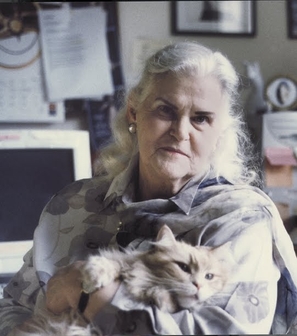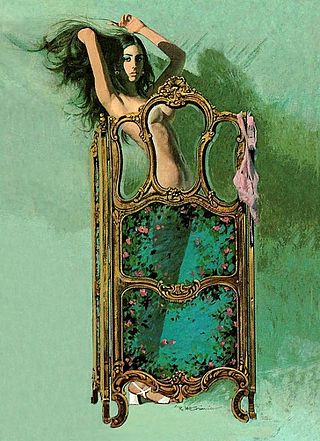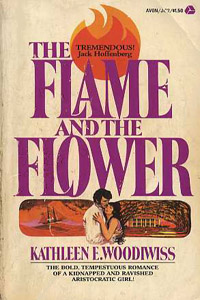Related Research Articles

Anne Inez McCaffrey was an American writer known for the Dragonriders of Pern science fiction series. She was the first woman to win a Hugo Award for fiction and the first to win a Nebula Award. Her 1978 novel The White Dragon became one of the first science-fiction books to appear on the New York Times Best Seller list.

A romance novel or romantic novel is a genre fiction novel that primary focuses on the relationship and romantic love between two people, typically with an emotionally satisfying and optimistic ending. Authors who have contributed to the development of this genre include Samuel Richardson, Jane Austen, and Charlotte Brontë.

Patricia Anne McKillip was an American author of fantasy and science fiction. She wrote predominantly standalone fantasy novels and has been called "one of the most accomplished prose stylists in the fantasy genre". Her work won many awards, including the World Fantasy Award for Lifetime Achievement in 2008.

Fred Marcellino was an American illustrator and later an author of children's books who was very influential in the book industry. Publisher Nan Talese said that Marcellino could "in one image, translate the whole feeling and style of a book." Such was the case with his evocative painting for Judith Rossner's August, published and edited by Talese.

Men's adventure is a genre of magazine that was published in the United States from the 1940s until the early 1970s. Catering to a male audience, these magazines featured pin-up girls and lurid tales of adventure that typically featured wartime feats of daring, exotic travel or conflict with wild animals. These magazines were also colloquially called "armpit slicks", "men's sweat magazines" or "the sweats", especially by people in the magazine publishing or distribution trades.
Rowena A. Morrill, also credited as Rowena and Rowina Morril, was an American artist known for her science-fiction and fantasy illustration, and is credited as one of the first female artists to impact paperback cover illustration. Her notable artist monographs included The Fantastic Art of Rowena, Imagine, Imagination, and The Art of Rowena and her work has also been included in a variety of anthologies including Tomorrow and Beyond and Infinite Worlds.

Lesbian pulp fiction is a genre of lesbian literature that refers to any mid-20th century paperback novel or pulp magazine with overtly lesbian themes and content. Lesbian pulp fiction was published in the 1950s and 1960s by many of the same paperback publishing houses as other genres of fiction, including westerns, romances, and detective fiction. Because very little other literature was available for and about lesbians at this time, quite often these books were the only reference the public had for modeling what lesbians were. English professor Stephanie Foote commented on the importance of lesbian pulp novels to the lesbian identity prior to the rise of organized feminism: "Pulps have been understood as signs of a secret history of readers, and they have been valued because they have been read. The more they are read, the more they are valued, and the more they are read, the closer the relationship between the very act of circulation and reading and the construction of a lesbian community becomes…. Characters use the reading of novels as a way to understand that they are not alone." Joan Nestle refers to lesbian pulp fiction as “survival literature.” Lesbian pulp fiction provided representation for lesbian identities, brought a surge of awareness to lesbians, and created space for lesbian organizing leading up to Stonewall.
Lynn Picknett is an English writer of books that are mainly about religious history and popular conspiracy theories, the paranormal, the occult, and historical mysteries.

Robert Edward McGinnis is an American artist and illustrator. McGinnis is known for his illustrations of more than 1,200 paperback book covers, and over 40 movie posters, including Breakfast at Tiffany's, Barbarella, and several James Bond and Matt Helm films.

Lesbian literature is a subgenre of literature addressing lesbian themes. It includes poetry, plays, fiction addressing lesbian characters, and non-fiction about lesbian-interest topics. A similar term is sapphic literature, encompassing works that feature love between women that are not necessarily lesbian.

Historical romance is a broad category of mass-market fiction focusing on romantic relationships in historical periods, which Walter Scott helped popularize in the early 19th century.

The Flame and the Flower is the debut work of romance novelist Kathleen E. Woodiwiss. The first modern "bodice ripper" romance novel, the book revolutionized the historical romance genre. It was also the first full-length romance novel to be published first in paperback rather than hardback.

A novel is an extended work of narrative fiction usually written in prose and published as a book. The English word to describe such a work derives from the Italian: novella for "new", "news", or "short story ", itself from the Latin: novella, a singular noun use of the neuter plural of novellus, diminutive of novus, meaning "new". According to Margaret Doody, the novel has "a continuous and comprehensive history of about two thousand years", with its origins in the Ancient Greek and Roman novel, Medieval Chivalric romance, and in the tradition of the Italian Renaissance novella. The ancient romance form was revived by Romanticism, in the historical romances of Walter Scott and the Gothic novel. Some novelists, including Nathaniel Hawthorne, Herman Melville, Ann Radcliffe, and John Cowper Powys, preferred the term "romance". M. H. Abrams and Walter Scott have argued that a novel is a fiction narrative that displays a realistic depiction of the state of a society, while the romance encompasses any fictitious narrative that emphasizes marvellous or uncommon incidents. Works of fiction that include marvellous or uncommon incidents are also novels, including Mary Shelley's Frankenstein, J. R. R. Tolkien's The Lord of the Rings, and Harper Lee's To Kill a Mockingbird. Such "romances" should not be confused with the genre fiction romance novel, which focuses on romantic love.
Kathy Lynn Emerson is an American writer of historical and mystery novels and non-fiction. She also uses the pseudonyms Kaitlyn Dunnett and Kate Emerson.
Richard Bober was an American artist best known for his work for science fiction, fantasy, and similar paperback novels.
Although, traditionally, female comics creators have long been a minority in the industry, they have made a notable impact since the very beginning, and more and more female artists are getting recognition along with the maturing of the medium. Women creators have worked in every genre, from superheroes to romance, westerns to war, crime to horror.
Elizabeth Safian Berube was an American comic book artist, best known as a romance comics artist for DC Comics in the 1970s. Simply signing her work "Elizabeth," her modern, stylized art was used to illustrate fashion features, horoscope pages, tables of contents, and other various ornamental pieces. She was also a prolific colorist, first for Archie Comics and later for DC. Throughout her career she worked on children’s books, greeting cards, and other commissioned work.
Anne Burke was an Irish novelist in the Gothic genre. She was one of the earliest women writers of Gothic fiction.
Ann Brewster was an American cartoonist and illustrator during the Golden Age of comics. She provided art for many different publishers, including Ace Magazines, Fiction House, and Atlas Comics. Brewster is most notable for illustrating romance comics. After a career as penciller and inker for comics, she transitioned to illustrating novels and children's magazines before retiring in 1980.
Elaine I. Duillo was an American painter and illustrator known for her romance fiction book covers. She was inducted into the Society of Illustrators Hall of Fame in 2003.
References
- 1 2 3 4 Lessard, Victoria. "A Brief History of the Clinch | Hazlitt". hazlitt.net. Penguin Random House.
- 1 2 3 4 Garcia, Karla. "Evolution of Romance Novel Book Covers". Inside Fullerton. Hornet Media.
- ↑ Bulger, Adam. "It's nothing but love at the Romance Writers of America convention". www.nypress.com. Straus News.
- 1 2 Mingle, Katie (2 June 2021). "The Clinch". 99% Invisible.
- ↑ Headlee, Celeste; Saxena, Kalyani (8 December 2023). "From chiseled abs to discrete illustrations: How romance covers have changed over time". www.wbur.org. Boston University. WBUR.
- ↑ Diehm, Jan. "What does a happily ever after look like?". The Pudding.
- ↑ "What's in a Name?". PublishersWeekly.com. 248 (27). 2 July 2001.
- ↑ Donaldson, Kayleigh (1 February 2024). "Why Does Every Romance Novel Have the Same Cartoon Cover Right Now?". Paste Magazine. Wolfgang's. Paste Media Group.
- ↑ Wallentine, Anne (25 February 2022). "Can We Still Judge a Romance Novel by Its Cover?". Electric Literature. Electric Literature.
- ↑ "Lynn Munroe Books". lynn-munroe-books.com. Lynn Munroe Books.
- ↑ Kaler, Anne K.; Rosemary E. Johnson-Kurek (1999). Romantic conventions. Popular Press. p. 35. ISBN 978-0-87972-778-9.